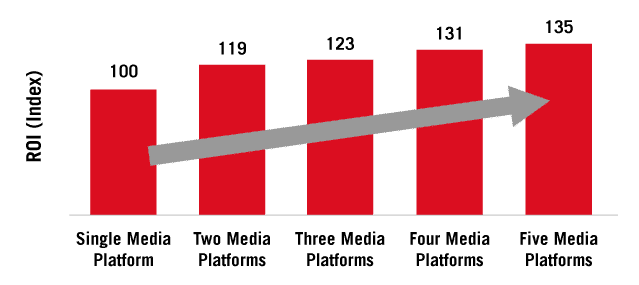Cross-Channel Campaign Management: online & offline marketing


There’s a lot to consider when choosing the right channels for your marketing campaign. While e-commerce has gained popularity, 80% of retail purchases still happen in-store. Meanwhile, most shoppers research products online before purchasing. So do you focus on digital or physical channels? Well, the correct answer is both. We are truly in an omnichannel world where retailers and brands must deploy cross-channel marketing campaigns that meet consumers online and offline. But what is a cross-channel campaign? And how you can ensure effective management to drive return on investment.
Cross-channel marketing campaigns meet customers throughout their buying journey across multiple channels, including online and offline. While many advertising and marketing campaigns focus on a specific channel, cross-channel campaigns take a holistic marketing approach. They tend to focus on a single message and distribute it through multiple channels to reach their target audience at different stages in the buying cycle.
So, cross-channel marketing campaigns can be incredibly effective. However, given the breadth of channels, it becomes challenging to plan, execute and analyse them.
Customers interact with brands via multiple channels. They might hear about you for the first time via a TV ad, follow your Instagram feed, visit your website to browse products, check out product reviews via UGC on TikTok, purchase in-store, leave reviews on Facebook and request customer support on Twitter. Or there are myriad other ways customers can use to gather information and purchase your products.
Needless to say, the customer journey has never been more complicated. As marketers, it is our job to reach our customers with the information they need, when they need it, in the format they want it.
Unfortunately, this creates some challenges. Every channel is different. They each have their own subtleties and quirks that make them different. So, every marketing team will have a specialist for each discipline. And while some marketers are generalists, there will be very few (if any) experts in every channel. The field is simply too broad.
This is where cross-channel marketing campaign management comes in.
Cross-channel campaign management aligns internal and external marketing teams to deliver a cohesive marketing campaign that engages customers at multiple touchpoints throughout the buyer journey. This role may be conducted by a head of marketing, responsible for overseeing campaign delivery and brand management.
This is not an easy task, with multi-disciplinary marketers and many tools to stay on track. So what are the benefits of this cross-channel approach versus delivering campaigns through individual channels?
As marketers, we often pigeonhole ourselves into specialist categories – and we’ll happily fight other marketers over it. Well, whether you’re a digital marketer, brand marketer or social media marketer, the best marketing campaigns utilise multiple channels to engage their target audience.
In a study of the 3200 marketing campaigns between 2010-2015, Analytic Partners found that every additional channel included in the campaign increased the overall effectiveness. On average, they found that campaigns using 2 channels were 19% more effective than those using just 1. Adding a 3rd channel increased the campaign ROI by 23%. The trend continued up to 5 channels. The chart below demonstrates the trend.

Courtesy of Analytics Partners
So, in the question of whether we should use traditional or digital marketing channels, the answer is both.
Cross-channel marketing campaigns epitomise this approach by starting with the customer and the message rather than the delivery channel. By creating a campaign that works on multiple channels, you significantly increase the Return on investment of your campaigns.
Executing your cross-channel campaign relies on a customer-centric approach. Here’s a simple framework to ensure you plan your campaign for success.
The first step to developing your cross-channel campaign is understanding your target customers. People buy from you differently, and you need to identify which customers you will target with your campaign. Deciding on your target audience will inform how you deliver your campaign, your core message, and the channels you use.
Review your first-party data from loyalty cards, e-commerce registrants and email lists to understand the demographics of shoppers. In addition, you can review POS data from physical stores to identify which products are popular in different areas. On average, 80% of retail purchases happen in-store, so this can be an effective way to segment product promotions and campaigns by region.
Group buyers based on similarities so you can identify large segments to target with your campaigns. You may choose to focus on a segment which is large overall, but only a small portion of them currently buy from you. This can be incredibly effective for growing market share but will require different messaging to your existing strategies.
To build out your campaign audience and get your targeting right, check out our article on campaign targeting.
With your target audience confirmed you need to develop your campaign strategy.
A good campaign strategy will include the following:
Then it is critical to ensure this plan is shared with the entire team throughout the campaign lifecycle. Many campaigns will take place over a few months, and with multiple stakeholders, individuals are likely to change. So this plan needs to be available, accessible and constantly maintained with new information.
Your campaign plan becomes the single source of truth for your cross-channel marketing. It will ensure all parties are aligned around a common objective and understand their role in achieving success.
Learn how Colateral’s campaign management software provides a single source of truth across multiple channels.
Managing cross-channel campaigns isn’t a one-way communication. It’s critical that you monitor each channel’s creative execution so that the campaign works together as a whole.
While the entire campaign is connected, each channel will play a different role. Your TV or online video ad may aim to entertain the customer and raise awareness. Meanwhile, your social media may deploy expert thought leadership, and your in-store promotions may focus on the key benefits and prices to drive transactions.
Set channel-dependent KPIs and ensure a regular communication loop to ensure each component is meeting its objectives.
Despite all of your planning, your campaign may still not be perfect.
It’s critical to monitor KPIs and conduct customer surveys to ensure your campaign has the desired impact. Waiting until your campaign ends for the post-mortem to discover one part was out of sync could cost your brand millions in ad spend and lost revenue.
If you can sync your channel management platforms with your cross-channel campaign management software, you will be able to monitor real-time data. This will provide real-time updates on campaign performance.
One channel often neglected in marketing campaign analysis is in-store marketing. Often, this is simply because the data doesn’t exist. Read our latest article on how to measure the effectiveness of in-store marketing.
With real-time analysis available across multiple channels, you will be equipped to make decisions to ensure campaign success. However, it’s critical to have a regular cadence to review the campaign performance with channel experts and commission customer surveys to discover the root cause of issues.
If you did a good job with your research up front, it’s often better to maintain consistency of message than pivot every 2 weeks. But don’t be afraid to listen to what the data and experts tell you. If sufficient evidence suggests you should change, pivoting quickly and decisively can save a failing campaign.
If you want to learn more about delivering successful marketing campaigns, join hundreds of marketers by subscribing to our newsletter.
 Thought Leadership
Thought Leadership
Despite the rise of e-commerce, 80% of purchases still happen in stores. And retailers produce...
 Thought Leadership
Thought Leadership
Nothing captures someone's attention more than a message tailored specifically to them. And shoppers now...